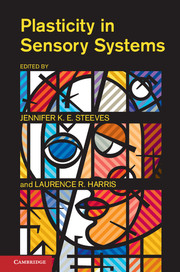Refine search
Actions for selected content:
48285 results in Computer Science
Thinking as Computation: A First Course by Hector J. Levesque, The MIT Press, 2012. Hardcover, ISBN 978-0-262-01699-5, xx + 299 pp.
-
- Journal:
- Theory and Practice of Logic Programming / Volume 13 / Issue 1 / January 2013
- Published online by Cambridge University Press:
- 09 January 2013, pp. 143-145
-
- Article
- Export citation
TLP volume 13 issue 1 Cover and Back matter
-
- Journal:
- Theory and Practice of Logic Programming / Volume 13 / Issue 1 / January 2013
- Published online by Cambridge University Press:
- 09 January 2013, pp. b1-b6
-
- Article
-
- You have access
- Export citation
An in-situ algorithm for expanding a graph
-
- Journal:
- Journal of Functional Programming / Volume 23 / Issue 2 / March 2013
- Published online by Cambridge University Press:
- 07 January 2013, pp. 174-184
-
- Article
-
- You have access
- Export citation

Plasticity in Sensory Systems
-
- Published online:
- 05 January 2013
- Print publication:
- 17 December 2012
Expanders Are Universal for the Class of All Spanning Trees
-
- Journal:
- Combinatorics, Probability and Computing / Volume 22 / Issue 2 / March 2013
- Published online by Cambridge University Press:
- 03 January 2013, pp. 253-281
-
- Article
- Export citation
Rate-dependent seam carving and its application to content-aware image coding
-
- Journal:
- APSIPA Transactions on Signal and Information Processing / Volume 2 / 2013
- Published online by Cambridge University Press:
- 27 February 2013, e1
- Print publication:
- 2013
-
- Article
-
- You have access
- Open access
- HTML
- Export citation
On characteristic formulae for Event-Recording Automata∗
-
- Journal:
- RAIRO - Theoretical Informatics and Applications / Volume 47 / Issue 1 / January 2013
- Published online by Cambridge University Press:
- 10 January 2013, pp. 69-96
- Print publication:
- January 2013
-
- Article
- Export citation
Constant frame quality control for H.264/AVC
-
- Journal:
- APSIPA Transactions on Signal and Information Processing / Volume 2 / 2013
- Published online by Cambridge University Press:
- 01 May 2013, e3
- Print publication:
- 2013
-
- Article
-
- You have access
- Open access
- HTML
- Export citation
Some results on complexity of μ-calculusevaluation in the black-box model∗
-
- Journal:
- RAIRO - Theoretical Informatics and Applications / Volume 47 / Issue 1 / January 2013
- Published online by Cambridge University Press:
- 10 January 2013, pp. 97-109
- Print publication:
- January 2013
-
- Article
- Export citation
Strong functors and interleaving fixpoints in gamesemantics∗
-
- Journal:
- RAIRO - Theoretical Informatics and Applications / Volume 47 / Issue 1 / January 2013
- Published online by Cambridge University Press:
- 10 January 2013, pp. 25-68
- Print publication:
- January 2013
-
- Article
- Export citation
Visual quality assessment: recent developments, coding applications and future trends
-
- Journal:
- APSIPA Transactions on Signal and Information Processing / Volume 2 / 2013
- Published online by Cambridge University Press:
- 11 July 2013, e4
- Print publication:
- 2013
-
- Article
-
- You have access
- Open access
- HTML
- Export citation
Reversible color transform for Bayer color filter array images
-
- Journal:
- APSIPA Transactions on Signal and Information Processing / Volume 2 / 2013
- Published online by Cambridge University Press:
- 27 September 2013, e5
- Print publication:
- 2013
-
- Article
-
- You have access
- Open access
- HTML
- Export citation
Dark and low-contrast image enhancement using dynamic stochastic resonance in discrete cosine transform domain
-
- Journal:
- APSIPA Transactions on Signal and Information Processing / Volume 2 / 2013
- Published online by Cambridge University Press:
- 12 November 2013, e6
- Print publication:
- 2013
-
- Article
-
- You have access
- Open access
- HTML
- Export citation
Seven new champion linear codes
- Part of
-
- Journal:
- LMS Journal of Computation and Mathematics / Volume 16 / October 2013
- Published online by Cambridge University Press:
- 01 January 2013, pp. 109-117
-
- Article
-
- You have access
- Export citation
Behavior signal processing for vehicle applications
-
- Journal:
- APSIPA Transactions on Signal and Information Processing / Volume 2 / 2013
- Published online by Cambridge University Press:
- 04 March 2013, e2
- Print publication:
- 2013
-
- Article
-
- You have access
- Open access
- HTML
- Export citation
A non-uniform finitary relational semantics of systemT∗
-
- Journal:
- RAIRO - Theoretical Informatics and Applications / Volume 47 / Issue 1 / January 2013
- Published online by Cambridge University Press:
- 10 January 2013, pp. 111-132
- Print publication:
- January 2013
-
- Article
- Export citation
Avoiding Arrays of Odd Order by Latin Squares
-
- Journal:
- Combinatorics, Probability and Computing / Volume 22 / Issue 2 / March 2013
- Published online by Cambridge University Press:
- 21 December 2012, pp. 184-212
-
- Article
- Export citation
Asymptotic Normality Through Factorial Cumulants and Partition Identities
-
- Journal:
- Combinatorics, Probability and Computing / Volume 22 / Issue 2 / March 2013
- Published online by Cambridge University Press:
- 21 December 2012, pp. 213-240
-
- Article
- Export citation
Quantum attacks on pseudorandom generators†
-
- Journal:
- Mathematical Structures in Computer Science / Volume 23 / Issue 3 / June 2013
- Published online by Cambridge University Press:
- 20 December 2012, pp. 608-634
-
- Article
- Export citation















